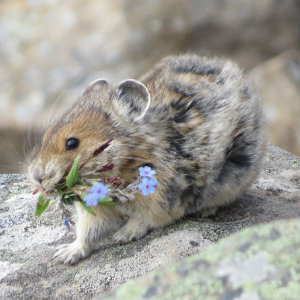AMERICAN PIKA

Clinton W. Epps, Donelle Schwalm, Jessica Castillo
Latin name: Ochotona princeps
The American pika is considered a sentinel species for the potential impacts of climate change on wildlife. They have a low thermal threshold, which means that exposure to temperatures just a few degrees above their body temperature results in mortality in a very short time. Pikas escape warm day time temperatures by sheltering in the cool refugia offered by rocky talus slopes, boulder fields, lava tubes, and even mining tailing piles. In addition, because they remain active all winter, they rely on snow accumulation to provide a buffer from extreme winter temperatures. As a result, the warming temperatures and changing precipitation patterns associated with climate change threaten the persistence of the species - at least, in parts of its range. Pikas are believed to have disappeared from areas in the Great Basin due to climate change impacts.
However, it is unclear if these losses translate unilateraly to pika populations in other parts of the species' range. The Pikas in Peril project studies climate change vulnerability of pika populations in eight National Parks and Monuments: Crater Lake, Craters of the Moon, Grand Teton, Great Sand Dunes, Lassen Volcanic, Lava Beds, Rocky Mountain and Yellowstone. These parks were chosen because they capture much of the variation in temperature, precipitation, elevation and habitat substrate in which pikas occur.
Did you know? They collect hay and are coprophagous (consume feces or dung).
Publications:
Castillo et al. 2014 (Molecular Ecology), Castillo et al. 2016 (Ecological Applications), Jeffress et al. 2013 (Ecological Applications), Schwalm et al. 2016 (Global Change Biology)
